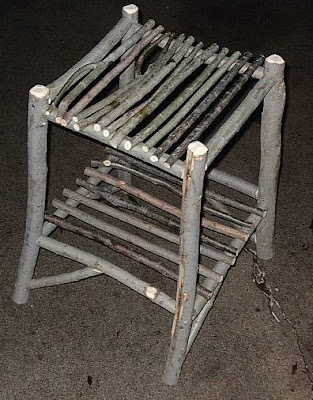To complete the most BASIC of projects, you need just a knife. Get one of these or one of these. The Swedish "Mora" style carving knives are the best deal in steel. They are high-quality, simple, and very functional. I use mine for EVERYTHING in the shop.
 The fifteen dollar version comes with no sheath (not a problem really, you can make one, or just keep it on the bench). The $30 style is a little nicer, comes pre-sharpened and with a cheesy plastic sheath. Actually, the sheath isn't bad, very functional. Surprisingly, I've found that the cheaper version without the handle-ferrule is actually a little more durable. The handle on my fancy model broke, so I replaced it with a chunk of red-birch for a handle. Looks great, feels good to the hand, and it's outlasted the original. Then again, I haven't beaten on it with a hammer since breaking the original....
The fifteen dollar version comes with no sheath (not a problem really, you can make one, or just keep it on the bench). The $30 style is a little nicer, comes pre-sharpened and with a cheesy plastic sheath. Actually, the sheath isn't bad, very functional. Surprisingly, I've found that the cheaper version without the handle-ferrule is actually a little more durable. The handle on my fancy model broke, so I replaced it with a chunk of red-birch for a handle. Looks great, feels good to the hand, and it's outlasted the original. Then again, I haven't beaten on it with a hammer since breaking the original....Sharpening is a snap, because all Swedish mora-style knives are flat-ground (Like example number 3).

After the knife, you will need some pruners. There are two basic kinds: anvil and bypass. The anvil pruner is great for pruning roses, but for hacking a thumb-sized willow in two with one hand... they leave a LOT to be desired. The bypass pruner is your best friend (next to your knife, of course). I have owned three pair. A $6 set from DomeHepot, which worked OK until the blade chipped, got dull, and the pivot joint loosened. Then I stepped up to a $20 pair of Corona forged steel pruners.
Didn't like two things about them: they are green and get lost easily, and they have never held much of an edge. Corona is still a good brand and I think I just got a bad one.
But if you want the ULTIMATE in hand pruners, go with a Felco pruner Model F2.

You can disassemble them for adjustment and cleaning, sharpen the blade (or replace it) and adjust how tight or loose the pivot. They are forged aluminum (not steel, unfortunately) but they are very strong and have a little "flex" in them when you bear down with both fists on a hard branch. The worst thing about Felco pruners is that they are hard to come by locally. I found some at a landscapers supply store, but you can get them online. They are about twice as expensive as the Corona's but I feel they were worth it. I usually don't spend that much for a hand tool.
Felco tools online.
Saws: I have gone through more saws than knives and pruners combined! It seems they just take a beating. Folding pruning saws, fixed pruning saws, short-toolbox crosscuts, long curved Japanese saws, bow saws, you name it, I've used it. (Actually, I've never used a chain saw for collecting willows. I'll explain more about why in a later post). Currently, I have two philosophies about saws: use a good hand saw in the field, and a good electric circular saw in the shop. Of course, I've built a LOT of furniture without a circ saw, and you can too.
The main qualities to look for in a handsaw are:
- Cuts on the pull stroke
- Big teeth for clearing lots of chips fast in green wood
- Cuts cleanly (as possible)
- No shorter than 10" and no longer than 18"
- Comfortable, brightly colored handle (so you can find it in the thicket)
- Costs less than $20
Get a good quality fixed-blade, somewhat curved pruning saw from your local hardware store.

This is what I currently use, and those needle teeth have nicked me many-a-time. Make a flat pouch sheath out of cardboard, wood or leather (whatever you know how to work with).
A Hammer rounds out your tools. You don't need anything fancy, just some garage-sale bone. I happened to find a nice Estwing forged hammer many, many years ago at a farm sale. My dad bought it for me, and I've used it ever since.
It looks like this one, but brown with age and use. I love that thing!
 The Stanley Surform tool is awfully handy too. A good knife will do anything that the surform will do, but the poor-mans-plane is pretty handy to have around.
The Stanley Surform tool is awfully handy too. A good knife will do anything that the surform will do, but the poor-mans-plane is pretty handy to have around._______________
Rocky Canyon Rustics is THE Place on the Internet for ordering a rustic sign. Contact me through the blog for a design session.




















